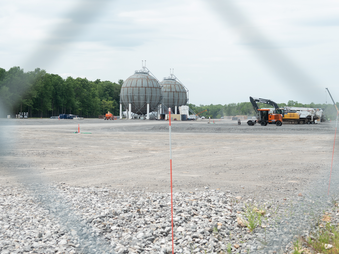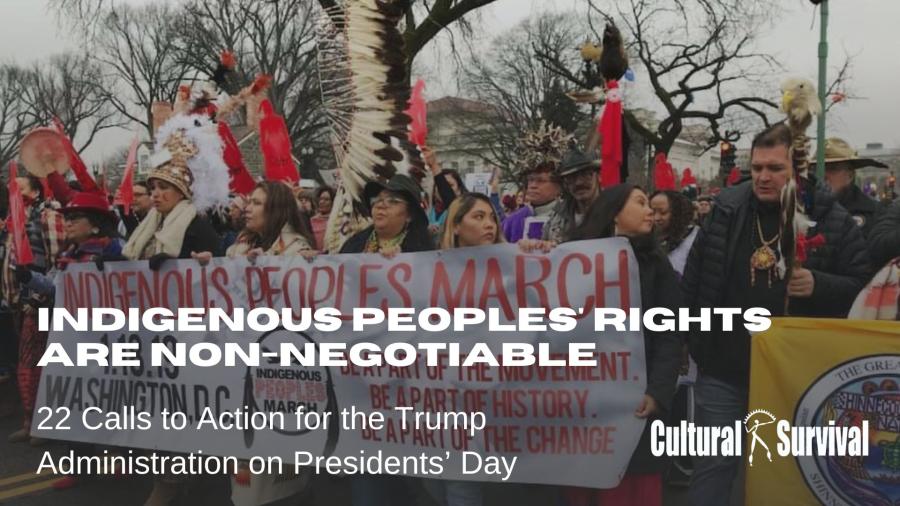
By Tia-Alexi Roberts (Narragansett, CS Staff)
The Western New York Science and Technology Advanced Manufacturing Park (STAMP) project is a proposed 1,263-acre industrial “mega-site” located in Alabama, NY, next to the Tonawanda Seneca Nation, and surrounded by the Iroquois National Wildlife Refuge, Tonawanda Wildlife Management Area, and John White Wildlife Management Area. Initially proposed in the early 2000s, it is being promoted by the Genesee County Economic Development Center, which has received millions of dollars in state funding to push the project. Plans for the industrial mega-site developed a decade ago claim it could create up to 9,000 jobs, which could bring more than 800 car and 600 diesel truck trips to the site each day. In addition, the developers aim to build a pipeline to bring six million gallons per day of fresh water from the Niagara River to the site, as well as a wastewater pipeline that would dump treated sewage and industrial wastewater into Oak Orchard Creek, a Lake Ontario tributary. At present, the site has just one tenant, Plug Power, which recently suspended construction of its proposed facility at STAMP, informed the U.S Securities and Exchange Commission (SEC) of potential insolvency, and announced a company-wide hiring freeze.
This fall, the developer’s efforts to begin construction of the proposed wastewater pipeline were halted after spills of drilling fluid and damage to roadways. On November 29, 2023, the Tonawanda Seneca Nation initiated a federal lawsuit against the U.S. Fish and Wildlife Service contesting the agency's approval of a right-of-way permit for the industrial wastewater pipeline through the Iroquois National Wildlife Refuge, alleging that the permit violated federal laws that protect the Refuge, the environment, and the Nation. Cultural Survival recently spoke to Christine Abrams (Tonawanda Seneca), who works as Administrator for the Tonawanda Seneca Nation Council of Chiefs, about the concerns surrounding the STAMP project.
Cultural Survival: Tell us about the Tonawanda Seneca Nation: who is the Tonawanda Seneca Nation, and what is your relationship to the land?
Christine Abrams: The Tonawanda Seneca Nation is a member Nation of the Haudenosaunee, sometimes referred to by outsiders as the Six Nations or Iroquois Confederacy. We maintain the traditional form of government given to us by our Great Law, and we live on a very small part of our ancestral territory. Our reservation territory is about 7,500 acres. I was born here; I am 71 and have mostly lived here my whole life. This is a land that was fought [for] by my ancestors during the nineteenth century. [The U.S. government was] trying to force us to move to Kansas. We did not move. [We] stayed here where we had been for many generations. Our territory was reduced from what was guaranteed to us by federal treaty in 1794. From millions of acres at that time, we were reduced to 45,000 acres in 1797, and then the state and federal government tried to reduce us to zero. My ancestors fought to hold on to our Territory, even after a state treaty claiming to purchase all our land. We never left, but we had to buy our own land back. In 1857 the United States confirmed our rights to the 7,500 acres we continue to hold today. We are surrounded by greenery and woods – these are the resources that we rely on and what we use for our ceremonies.
CS: How will the STAMP project affect the Tonawanda Seneca Nation and your relationship to the ecosystems?
CA: With the light, noise, and traffic, it's going to have terrible effects on our Nation. It will chase away our deer and harm other species. And it is not just our people who depend on the Big Woods. People from other Haudenosaunee Nations come to the Big Woods to hunt, fish and gather; STAMP would cause harm to these Nations, too. Pollution could end up in our water and environment. We are afraid of how this will affect all life.
CS: Plug Power is a project and company focused on "green hydrogen" that is working to establish itself at STAMP. What is your perspective on the environmental impact and sustainability of projects like this?
CA: We don’t believe Plug Power’s hydrogen production process is green energy. They would take energy from the grid instead of making their own, and then send their hydrogen canisters around the country using diesel trucks. And we don't know enough about their process and are really scared about what could happen. There have been situations where there have been explosions, which could be catastrophic for the Nation.
CS: Have you been able to build coalitions with any other local communities or stakeholders that oppose the project?
CA: We are a small Nation but we have worked hard to educate surrounding communities about the risks posed by STAMP. Once people learn what is planned here and what the impacts could be throughout Western New York, they become very concerned. When the STAMP developer applied to kill threatened and endangered species on the STAMP site, many people from this area came out to oppose the application. And when the developer started to drill a wastewater pipeline through the Iroquois National Wildlife Refuge, many local citizens opposed it. Orleans County even filed a lawsuit to stop it.
CS: What is motivating you to push back against the STAMP project?
CA: A lot of times I get emotional about this because not only will it affect natural life, but it will also affect our people down the line. We don't know what this development will do to our lands. Will the deer be plentiful for our children and grandchildren? Everything will be affected. We are fighting so hard because it is our job to fight for our future generations. It’s a threat to our way of life and will affect our ceremonies. We will have our ceremonies right down to the last strawberry. We want to show our future generations that they have to fight to protect what we have.
CS: What were the specific incidents that led to the suspension of pipeline construction in the Iroquois National Wildlife Refuge?
CA: It was a leakage of the drilling fluid that is used for horizontal directional drilling. This happened just weeks after drilling began in July, but the Nation and the public did not learn about all the spills until many weeks later. Now we know that there were at least five separate spills and that the fluid contained hazardous waste as well as arsenic, barium, cadmium, lead, acetone, pyrene, and phthalates. The developer still has not properly cleaned up the spills, and we learned just last week that a container holding toxic fluid was leaking into the waters. The drilling also damaged Route 63, the main road through the Refuge. It created sinkholes and separated the roadway from the shoulder. Now the developer is saying the soils there can’t support directional drilling, and they want to dig an open trench instead.
Photo by Jess Cherofsky. All rights reserved.
CS: What are your concerns regarding the spills of hydraulic drilling fluid and their potential impact on the wildlife and habitat in the area?
CA: As caretakers of Mother Earth, our concerns do not stop at our territory borders, especially if they are lands that were once ours. Our original territory includes part of the Refuge. The Refuge is a swampy area, but it holds life. There are salamanders, even one that is endangered. The spill polluted the water—how can we not assume it killed insects and other microscopic animals and plants? Plus, if the fluid just sits there in the Refuge, what further damage can it cause? And should there be rain, will it not travel further into the Refuge? Another concern [is that] the water will find its way into the wells on the territory. Only wells exist on the territory, no water lines. It may also make its way into the nearby creeks; one is Oak Orchard Creek, which is where the outflow from the Wastewater Treatment Facility on the STAMP site would go. There are too many questions which we have no answers to yet.
CS: How do you view the emergence of sinkholes and road damage along the construction route in terms of their implications for the local environment and community?
CA: The sinkholes and other damage show that the ground cannot handle the work that is being done. Not enough soil testing or analysis was done of how drilling would impact the area. The drilling project should never have been allowed to happen.
CS: In your opinion, what significance does the suspension of pipeline construction hold for the protection of the Iroquois National Wildlife Refuge and its ecosystem?
CA: If no work, no impacts to the Refuge. It will remain in the state it was meant to exist, to protect all that lives there and welcome all that partake there seasonally.
CS: What specific reasons do you have for opposing the resuming of construction, even after the required steps are completed as outlined by the U.S. Fish and Wildlife Service?
CA: The opposition to the construction is the same before and after the drilling fluid leaks. What we feared would happen happened—leakage into the Refuge, polluting the Refuge, causing harm to what lives in the water and on the lands of the Refuge. We have concerns that once the pipes are installed, there is a potential for leakage. We do not know how long those pipes will hold up. A break could happen, and then wastewater [would] seep into the ground and water of the Refuge. The construction project was absent from any consultation with the Nation. The Fish and Wildlife Service has the obligation as a federal agency to talk to us. The pipeline is connected to STAMP, which we oppose overall as well. A federal agency that wants to support part or all of STAMP has an obligation to consult with the Nation first and study what the impacts would be.
CS: What are your thoughts on the requirement for state agencies to certify remediation and road repair efforts? Do you believe it will adequately address your concerns?
CA: Even the developer now admits the soil isn’t appropriate for drilling. Meeting the conditions will not change that fact.
CS: Are there any environmental or wildlife preservation concerns associated with these construction-related issues that are being addressed in the process?
CA: We have many concerns about impacts on the environment and wildlife. These impacts have not been fully studied, partly because the developer is considered the “lead agency” for environmental review under New York state law. That is why the federal government needs to conduct a thorough review in consultation with the Nation.
CS: Could you elaborate on your position regarding the possible need for an independent federal review of the project?
CA: So far, the STAMP project has been funded with state money and pushed through state permitting processes. But the developer has always known federal permits and federal funding would be needed. They have tried to keep the feds out until the project is so far along it can’t be stopped, and the reason is that the federal government has special responsibilities to protect the environment and consult with the Nation. But the federal government already got involved with STAMP by issuing the permit for drilling through the Refuge. We are asking the federal government to honor its responsibility under federal law to consult with the Nation about the impacts of STAMP on our territory, people and culture before it is too late.
CS: In your perspective, what are the long term implications and concerns associated with the pipeline project?
CA: For the Refuge, the implication is that it suffered damage, it will not be the same [as it was] before the leakage of drilling fluid. It will take months, if not years, to heal, to recover from it being polluted by the drilling fluid. Should the GCEDC/STAMP Sewer Works be given permission to resume construction of the pipeline, it won’t be a matter of if, but when the next leak or a sinkhole will happen. It will be a lesson not learned. And in the bigger picture, the pipeline is a key part of the STAMP development as a whole. The implications of the entire development need more study and review.
CS: Is there anything else you would like the world to know about the Tonawanda Seneca Nation and your ancestral lands, or about the STAMP project and your efforts to resist?
CA: The Tonawanda Seneca Nation territory is at risk to suffer adverse impacts to its lands, wildlife, plant life, waters, the air, its pristine Big Woods, and to its people, specifically those yet unseen, meaning our future generations. [We] fear chemically-laden processes to produce a product that will threaten the health and safety of the people and all creation, fires and explosions from hydrogen production that is being touted as ‘green,’ yet a lot is unknown of this process.
The increase of traffic, mainly truck traffic, to the surrounding areas and to the territory that will increase air pollution. The presence of 9,000 employees if it happens. There will be a call for more housing, and more stores, so we will lose the rural setting and life. Our lives will change. The site will stick out like a sore thumb with the lighting, the noise, the infrastructure, the buildings, among other things, encased in the greenery of the Iroquois National Wildlife Refuge, the State Management Area, and the Tonawanda Seneca Nation territory.
What is wrong with this picture? The potential loss of what is presently in our Big Woods: the deer, medicine plants, maple trees, all that we give thanks for. The Big Woods provides what we need for our ceremonies, our customs, our way of life. We can only describe such loss as cultural genocide. We need to fight for our lands, our people, and future generations so that
They have what we have, carry on ceremonies, provide meat for their families for the winter, continue to heal their loved ones with medicinal plants, and enjoy and see the beauty of the trees.
Our ancestors were once threatened by removal. They refused to move and did what they had to do at that time. They were given money to move, but they used that money to go to court, which resulted in buying back 7,500 acres of our original lands for us. We were their future generation. Now we must fight as our ancestors did to protect and preserve the lands they refused to leave because it was home. We are protecting our home.
Top photo by Jess Cherofsky. Used with permission from TSN. All rights reserved.



